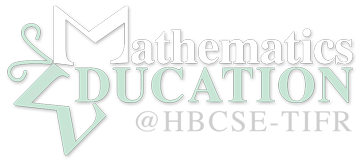Topology Games and Puzzles
In this section we have included games based on elementary principles of topology. Most of these games also contain an element of surprise and are entertaining.
Button Hole Puzzle
Material Required: a shirt or a piece of cloth with a button hole, some string, a pencil and cello tape.
First thread the string through the button hole as shown in the figure. Attach the pencil to the ends of the string with the tape. The puzzle is now to remove the pencil from the button hole without cutting the string. The solution is fairly simple: the pencil needs to be pulled through the loop in the string and through the button hole.
Belt and Buckle Puzzle
Material Required: belt with a buckle.
Like the previous puzzle, this is also fairly simple, but may still be new to most students. Many students are familiar with a peculiar change which sometimes takes place in the buckle of an ordinary belt. The pin suddenly is on the wrong side. Children often have no clue about how this happened, or how to get the pin on the right side again, without bending it. This can be posed as a puzzle. The solution lies in taking the belt completely through the buckle once.
Locking Paper Clips
Material Required: Strip of paper or transparent plastic, two paper clips.
Take a thin strip of paper about one inch wide, preferably cut from OHP transparency film. Fold it at one end to make a loop and secure it with a paper clip. Fold the other end to make a second loop and secure it with another paper clip. The two loops must make a ‘figure of 8’ as shown in the figure. Now hold the two ends of the paper strip and pull them apart sharply so that the paper strip straightens out. Watch what happens to the paper clips.
Interlocked Loops
Material Required: Two pieces of string each about 3 feet long.
Tie the first of the two strings to both the wrists of a student. Let the loop which passes over the wrists be loose. Tie the second string in a similar manner to the wrists of another student, but first allow it to pass under the first string, so that the two strings are interlocked. The puzzle is to disentangle the two strings without cutting them.
This puzzle is based on the fact that the two strings which look interlocked are not really so. The strings are open at the wrist although the loop appears to be closed here. Imagine that the hand is cut just below where the first string is tied to the wrist. Then it will be easy to take out the second string. Now imagine that the cut moves further and further up the hand. At one point it crosses the loop. Now let the second string which must pass through a cut in the hand also cross the loop. For this you must let it pass through the loop. Now take the second string over the fingers (where the hand is actually cut, that is, where the hand ends) and the strings disentangle easily.
String and Bead
Material Required: A long piece of string, three beads and a rectangular piece of wood.
Make three holes of about 1 cm diameter in the piece of wood, one in the centre and one near each edge. The beads must be big enough not to pass through the hole. Tie a bead at one end of the string and pass the other end of the string through a edge-hole in the piece of wood. Now take the string through the centre hole so that it forms a loop as shown in the figure. Thread the second bead through the string, take the string out through the other edge-hole in the piece of wood, and tie the last bead to the end of the string. The final arrangement is as shown in the figure. The puzzle is now to take the middle bead to the other loop in the string.
The principle is the same as in the previous puzzle. Hold the loop in the centre of the piece of wood with the thumb and fore- finger, pull it towards one of the edge-holes. Pass it through the edge-hole from below, take it over the edge bead and pull it back through the edge-hole. It becomes partly disentangled. Repeat this at the other edge-hole, and the string comes fully out of the centre hole, forming one large loop. Now move the middle bead to the place where you desire it to be and do the steps in inverse fashion. At the end of the two inverse steps, you are back to the original arrangement, but with the bead now in the other loop.


Where are the figures referenced?
“First thread the string through the button hole as shown in the figure. “
You can Click on the following link
http://mathedu.hbcse.tifr.res.in/wp-content/uploads/2014/01/Mathslab-English-Manual.pdf and you will be able to see it on page number 28.
Thanks.